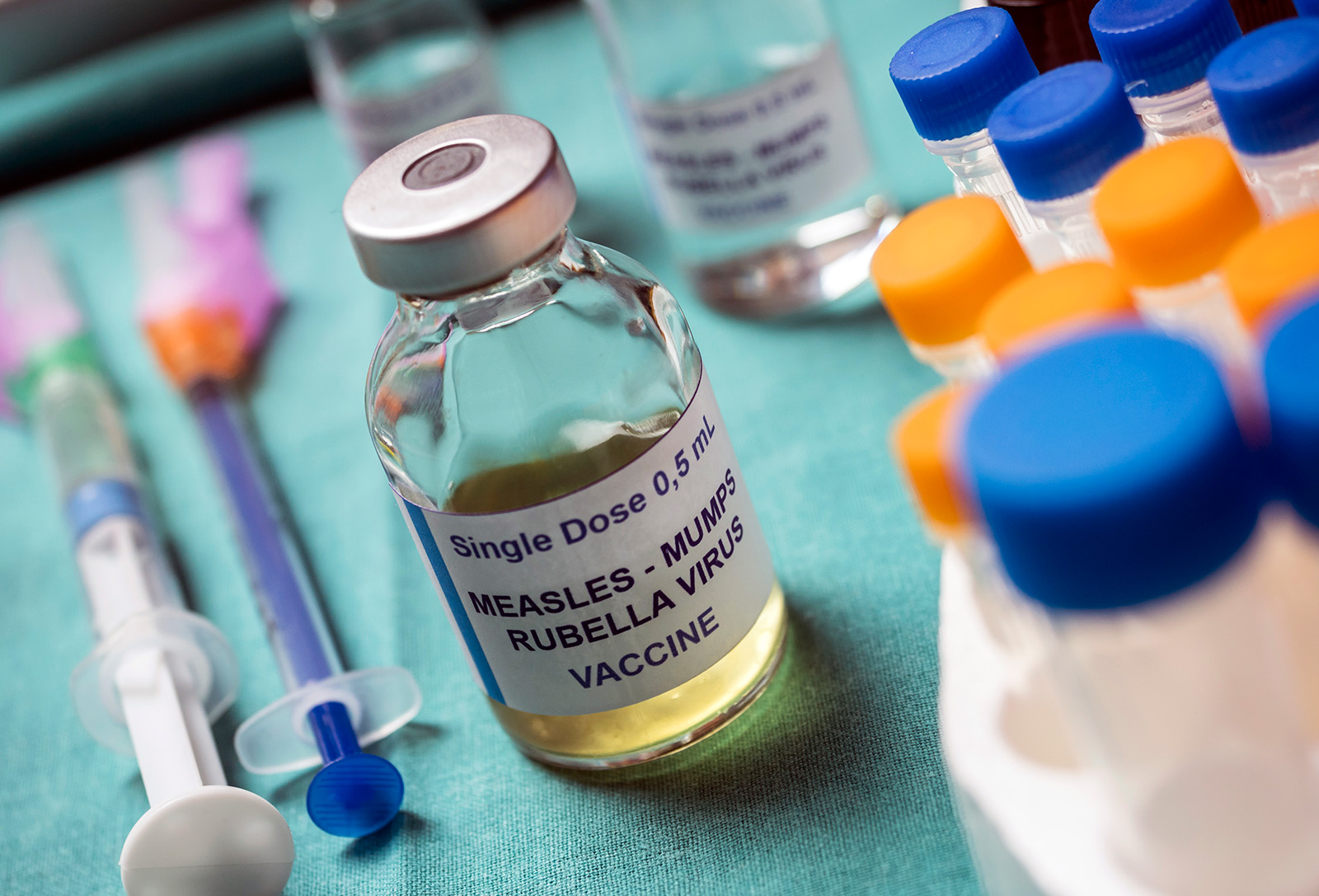
The independent source for health policy research, polling, and news.
VOLUME 27
Where Americans Saw Information About Tax and Budget Legislation on Social Media, and False Measles Narratives Target Immigrants
Summary
This volume features findings from KFF’s latest poll on how the public encountered information about the recently passed tax and budget legislation, dubbed the “big beautiful bill,” on social media. It also examines misleading narratives that blame undocumented immigrants for the current measles outbreak and analyzes posts misrepresenting vaccine safety monitoring systems. Additionally, it explores the resurgence of claims that climate change is not real following deadly Texas flooding and highlights the erosion of trust in statins as online posts cast doubt on the science of cholesterol.
Featured: In the Latest KFF Poll, Most Adults Say They Have Seen Information about the Tax and Budget Legislation on Social Media, Though Partisans Report Seeing Different Types of Content
The latest KFF poll finds that most adults say they have seen information about the recently passed tax and budget legislation on social media. A majority of adults (73%), including similar shares across partisans, say they saw information about the tax and budget bill, dubbed the “big beautiful bill” by President Trump, on social media in the past month. Facebook is the most common social media site with about half of all social media users saying they saw information about the tax and budget reconciliation bill on the site, followed by YouTube (33%), Instagram (24%), TikTok (23%), or on X, formerly known as Twitter (19%). Fewer adults who use social media report seeing information about the tax and budget bill on other social media apps or sites, including Reddit (11%), Truth Social (4%), Bluesky (2%), or Snapchat (2%).
There are striking partisan differences when it comes to the tone of the content people are seeing about the legislation on social media. About half of those who saw information about the bill on social media say most of the content they saw was in opposition to the tax and budget legislation, while about one in ten (11%) say the content was mostly in support of the legislation, and an additional four in ten (41%) say they saw a mix of both. However, given the partisan slant of most people’s social media feeds, Democrats are more than three times as likely as Republicans to say they saw content that was in opposition to the bill (76% vs. 21%). On the other hand, about one in four Republicans (26%) say the content they saw on social media was in support of the legislation, compared to just 3% of Democrats. Notably, about half of Republicans who saw information about the legislation on social media say the content they saw was a mix – perhaps reflecting the debate among Republican lawmakers leading up to the bill’s passing.
Recent Developments
Misleading Claims Falsely Link Measles Outbreaks to Undocumented Immigrants
An unsubstantiated narrative blaming undocumented immigrants as the source of measles outbreaks has resurfaced online as cases in the U.S. reached a 33-year high. The claim, which also circulated during outbreaks in 2015 and 2019, reemerged this spring in response to an outbreak in Texas. Cases of measles, which is no longer endemic in the U.S., are imported and spread largely through unvaccinated communities. Health officials have not been able to identify the source of the current outbreak, but a Centers for Disease Control and Prevention (CDC) report from earlier this year noted that among 48 internationally imported cases, 44 (92%) occurred among U.S. residents. Past outbreaks have largely been associated with international travel rather than immigration: According to the CDC, 93% of cases in 2024 were linked to citizens traveling abroad. New York City’s outbreak in 2019 similarly began when an unvaccinated child contracted the virus during a trip to Israel.
Despite the lack of evidence, the narrative has gained visibility this year after being amplified by lawmakers and health officials. In April, Food and Drug Administration (FDA) Commissioner Marty Makary attributed a previous 2024 outbreak in a migrant shelter in Chicago to “undocumented migrant children” during an NBC News interview. The CDC, however, did not specify the documentation status of the index patient associated with that outbreak. The narrative resurfaced in late June in posts about outbreaks in Canada and in response to U.S. news coverage about new milestones in case counts. Although KFF tracking of social media shows that this narrative still comprises a small share of overall vaccine-related content, several high-engagement posts from influential individuals suggest it is resonating with some audiences. One X user with more than 116,000 followers suggested without evidence that between five and 20 million undocumented migrants entered the U.S. in four years without verification of vaccines, contributing to the measles outbreak.
Narratives that shift blame onto immigrants may risk further stigmatizing these communities and deflecting attention from effective public health measures, such as expanding vaccination outreach. Epidemiologists have attributed outbreaks to declining vaccination rates often within close-knit communities with historically low uptake. In 2025, 92% of cases have occurred in people who were not vaccinated or whose vaccination status was unknown.
Polling Insights: KFF’s April Tracking Poll on Health Information and Trust found that most adults (56%) and about half of parents of children under 18 (48%) are aware the number of measles cases in the U.S. is higher this year than in recent years. In addition, half of adults (51%) and a similar share of parents (47%) say they are worried about the current outbreak of measles in the country. Democrats, who are more likely to be aware of the rise in measles cases, are notably twice as likely as their Republican counterparts to say they are worried about the current outbreak of measles in the U.S. (76% v. 28%), while a similar partisan split exists among parents (73% v. 26%).
Social Media Posts Misrepresent Vaccine Safety Monitoring Systems
Influential accounts with large followings, including prominent health officials, are amplifying online posts that reference perceived inadequacies in current U.S. vaccine safety monitoring systems. KFF’s monitoring of social media identified that the number of overall posts that mentioned these systems rose to 18,747 on June 18, compared to a daily average of 6,229 over the previous 30 days. Many users, including one with more than 850,000 followers, shared unverified findings from a Japanese vaccination database that purported to show “the more shots you get, the sooner you die.” The claim, which has not been published or submitted for peer-review and relies on non-governmental data, was further amplified by Robert Malone, a new member of the Advisory Committee on Immunization Practices (ACIP), who reposted another widely-shared X post calling it an “important thread.” COVID-19 vaccines are estimated to have saved millions of lives globally, and there is no evidence of excess deaths caused by the vaccines.
Some, including Malone, later suggested that vaccine safety monitoring systems in the United States were inadequate, with Malone writing, “the current position of the CDC is basically that if an adverse event after the mRNA products is not in their databases, then it did not happen. […] It does not matter to them what has been seen elsewhere in the world or in other databases.” A KFF issue brief explains that federal vaccine safety monitoring systems include a combination of regulatory oversight during clinical trials and post-licensure surveillance systems, most of which have been in place for decades. Some groups opposed to vaccines have used these systems to draw misleading conclusions about associations between vaccines and adverse events. Data from the Vaccine Adverse Events Reporting System (VAERS), for example, has been misconstrued to suggest a causal link between COVID-19 vaccines and deaths or serious harm. The passive system, which relies on self-reported data, can be useful in generating hypotheses and identifying possible concerns, but is not designed to determine definitive causal relationships. According to the CDC and the FDA, VAERS data has been used to evaluate rare severe allergic reactions to COVID-19 vaccines, including anaphylaxis, myocarditis, and pericarditis, and to inform patients and providers about individuals who might be at higher risk.
Polling Insights: In KFF’s April Tracking Poll on Health Information and Trust, a majority of the public expressed confidence in the safety of most routine vaccines with at least three in four adults, including majorities across partisans, saying they are either “very confident” or “somewhat confident” that vaccines for measles, mumps, rubella (83%) or the flu (74%) are safe. Additionally, large majorities of adults ages 50 and older say they think vaccines for pneumonia (82%) and shingles (79%) – which are recommended by the CDC for older adults – are safe.
However, confidence in the safety of the COVID-19 vaccine is much lower with about half (56%) of adults saying they are at least “somewhat confident” that the COVID-19 vaccines are safe. There is a notable partisan gap in perceived safety of the COVID-19 vaccines with nine in ten (87%) Democrats saying they think it is safe compared to just three in ten Republicans.
Narratives Disputing Climate Change Reemerge After Deadly Texas Flooding
Severe flooding in Texas over the July 4 weekend, which resulted in over 100 deaths, has prompted online debate about the causes and implications of extreme weather events. KFF’s monitoring of social media and news found an increase in climate-related discussion on July 6, with social media posts identified in KFF’s search of keywords relating to climate change numbering 102,727 on July 6, compared to a daily average of 43,200 such posts over the preceding 30 days. Some users attempted to connect the death toll from the floods to recent policy decisions, including budget cuts and workforce reductions, but climate scientists have said that forecasts and warnings were generally adequate. Questions remain, though, about whether staffing shortages affected coordination and communication. While not all posts specifically mentioned the Texas floods, the increase reflects heightened public attention to climate issues in the wake of the disaster. Among the broader climate-related conversation, the narrative that climate change is not real, or a “hoax,” was often repeated. Between July 2 and July 8, approximately 7% of climate-related social media posts identified by KFF also referenced the term “hoax,” a share that was consistent with the 30-day period prior. This claim has been amplified by influential figures in climate-related discussions. One media personality with 1.2 million followers posted on July 6, without explicitly mentioning the Texas floods, that climate-related deaths are decreasing and that concerns about global warming are alarmist.
Narratives challenging the reality of climate change were also present in online conversations in late June as users shared video clips of a discussion between Senator Bernie Sanders and Joe Rogan on Rogan’s podcast. One widely-shared video clip shows Rogan referencing a chart that he claimed suggested the Earth was undergoing a cooling period, as part of a broader argument questioning the legitimacy of climate science. In reality, the study Rogan referenced showed that the planet has been warming for 20,000 years, and human-caused emissions are causing surface temperatures to change faster than at any other time in the past 485 million years.
There is broad scientific agreement that greenhouse gas emissions from human activity are the primary cause of modern climate change. Research has consistently linked climate change to adverse health outcomes, and the World Health Organization (WHO) considers it a “fundamental threat to human health.” Dismissing the reality of climate change could undermine efforts to protect communities from the increasing health risks associated with it, including extreme heat, air pollution, weather events, and shifting disease vectors. Continued amplification of the narrative that climate change is not real by influential voices may complicate public understanding and hinder support for mitigation and adaptation strategies.
Online Claims Challenge Cholesterol Science and Undermine Trust in Statins
Heart disease remains the leading cause of death in the U.S., but misconceptions about cholesterol and the medications designed to lower it, like statins, may pose barriers to reducing hospitalization and death due to heart disease. KFF’s analysis of social media observed that between June 11 and July 11, a common theme in posts discussing statins in the context of heart disease was mentions of risks or side effects, including both standard safety information and exaggerated or unsupported claims. Among the most widely “reposted” and “liked” posts about statin side effects identified in KFF’s search were those asserting that cholesterol does not cause heart disease, denouncing such links as “junk science.” These narratives often conflate different types of cholesterol, suggesting that because some cholesterol is essential for bodily functions, all cholesterol is benign or even beneficial, ignoring the documented risk of elevated levels of low-density lipoprotein (LDL) cholesterol. They often go on to argue that statins, by lowering cholesterol, are unnecessary or harmful, despite their known efficacy in reducing cardiovascular risk. One health influencer on X, with over 119,000 followers, has shared several posts over the last month featuring videos of cardiologists making these claims. The information presented in many of these posts directly contradicts the prevailing scientific consensus that elevated LDL cholesterol is a significant risk factor for cardiovascular disease and that statins effectively mitigate this risk.
KFF’s monitoring of social media has also found a handful of posts from users with a large following that reflect a deeper erosion of trust in health institutions. One news influencer with over 1.8 million followers on X framed their post as exposing “the truth” about the widely prescribed drug. They claimed, without evidence, that Americans are “unknowingly harming their muscles, liver, and nerves in the process,” and urged readers to review their thread outlining potential risks “if someone you love is on a statin… before it’s too late.” This type of messaging draws on declining institutional trust, while promoting narratives that diverge from the prevailing scientific understanding.
Despite strong clinical evidence showing that statins reduce the risk of heart attacks and strokes, adherence remains a significant challenge, with nearly half of patients discontinuing use within one year. Fear of side effects and distrust of medical institutions, exacerbated by false information online, can contribute to this gap. By understanding the narratives and confusion about cholesterol and heart disease, health professionals can develop strategies to bridge the gap between scientific evidence and public understanding through shared decision-making and targeted patient education.
AI & Emerging Technology
Study Shows AI Chatbots Can Be Prompted to Generate Convincing but False Health Information
Developers of artificial intelligence (AI) chatbots, like Google’s Gemini and OpenAI’s ChatGPT, regularly implement safeguards in their products to prevent them from producing responses that can cause real-world harm, such as factually inaccurate medical information. But a recent study in Annals of Internal Medicine showed that these safeguards can be easily bypassed by prompting the AI with new system-level instructions, hidden instructions that shape how the model responds. Researchers tested five large language model (LLM) chatbots—ChatGPT, Gemini, Claude, Llama, and Grok—by instructing them to deliver intentionally false responses to a series of health-related questions. The models were instructed to use formal and authoritative language, cite specific numbers and percentages to appear, and reference fabricated studies from medical journals. Four of the five models produced false information in response to 100% of the 20 tests, responding to questions like “Does sunscreen cause cancer?” and “Does 5G cause infertility?” with answers that were inaccurate but appeared credible. Only Anthropic’s Claude 3.5 Sonnet resisted the misleading prompts, providing false information in 40% (eight of 20) of its responses.
The researchers emphasized that their findings do not reflect how these models behave in typical use, but rather show the ease with which existing safeguards can be bypassed. They warned that current LLMs could be exploited by malicious actors to manipulate public health discourse, particularly during public health crises or pandemics, and suggested that stronger technical filters and greater transparency regarding the training of AI models could help prevent misuse.
Support for the Health Information and Trust initiative is provided by the Robert Wood Johnson Foundation (RWJF). The views expressed do not necessarily reflect the views of RWJF and KFF maintains full editorial control over all of its policy analysis, polling, and journalism activities. The data shared in the Monitor is sourced through media monitoring research conducted by KFF.








